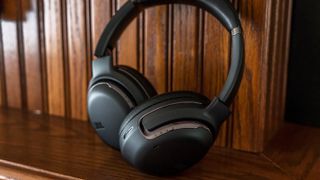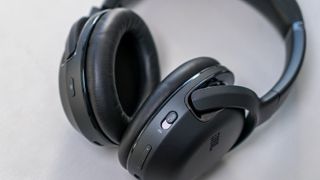TechRadar Verdict
JBL is trying to compete with big players with the Tour One Wireless and their sound, while good, isn’t exceptional. Similarly, while the functionality is fine as well, we’re left thinking these could have hit a higher note.
Pros
- +
Punchy bass, with custom EQ
- +
Pretty comfortable fit
- +
Solid battery life
Cons
- -
Ambient Aware needs work
- -
Sound quality has its limits
- -
Adaptive NC needs tweaking
Why you can trust TechRadar
One-minute review
Over-ear headphones have two jobs: fit comfortably and play audio well enough to truly enjoy the content. Sprinkled within those basic tenets are additional features that are supposed to enhance the experience. You could easily describe any over-ear pair that way, but the JBL Tour One Wireless are an interesting case because they’re designed to cater to a larger audience.
JBL can be hit or miss on its audio products, and the same could be said about the Tour One: the sound, while good, isn’t exceptional, and while the functionality is fine, we’re left thinking these could have hit a higher note.
There is potential for JBL to release improvements by way of a firmware update through the app, and had already done so once while we tested them. If the company keeps doing that, it may have enough to push them up the ladder as tougher competitors. For now, however, we'd still recommend a pair of cans from Sony or Bose if you want top-tier noise cancellation.
Price and release date
The JBL Tour One were released in May 2021 and come in at $300 / £279 (around AU$450). The challenge is that ballpark price has plenty of other headphones that can compete or play better, and that’s where things get complicated here.
For starters, that's just a little bit less money than the stellar Sony WH-1000XM4, what we consider to be the best noise-cancelling headphones on the market, and the Bose QuietComfort 35 II, which comes in a close second. Because ANC isn't the JBL Tour One's strong suit, both feel like better values despite their higher price.

Design
The Tour One Wireless don’t have any special design treatments to stand out in a crowded field. Look at them straight on and they resemble so many others. Gaze at them from the side and the neutral look also doesn’t particularly stand out. The gunmetal and black color scheme is old hat by now, but it still works, so these will fit right in if you’re not looking for anything too conspicuous.
The faux leather headband is soft enough to sink in without feeling like it pinches after a while, whereas the earcups have little wiggle room once you put them on. That’s great for stability, but perhaps not so much if you want your ears to breathe a little. JBL may have done this by design to better trap in the bass and avoid leakage that would otherwise dilute it.
Whatever the case, the fit may be divisive because, unlike the headband, you have little recourse to adjust the earcups. They do swivel, which helps contour to the shape if your head and ears, but if you don’t like the thinner padding or how they sit, there’s not much you can do about it. Plus, they do trap in heat, though we didn’t find it to be stifling enough to take them off for a breather all that often.
JBL did try to allocate controls in a symmetrical way. The right earpiece has a power switch that also doubles as the Bluetooth pairing button. Volume controls sit nearby, including a 2.5mm headphone jack when you want to use the Tour One Wireless in a wired form. The USB-C charging port is on the left cup, along with a solitary button to trigger your native voice assistant.
Interestingly, the right earcup’s entire outer surface is touch-sensitive, housing a number of controls. Play or pause with a simple tap, or double tap to skip a track. Unfortunately, there’s no way to repeat one. We tried triple tapping and got nothing. Tap and hold and you can cycle through active noise cancellation (ANC) and Ambient Aware. JBL’s Headphones app does offer some ways to customize those controls, like allocating voice assistants — Alexa, Google Assistant, Siri or Bixby — to the panel instead. In turn, you could apply the Ambient Aware mode to the button on the left earcup as well.
While we didn’t like not being able to repeat a track, we did appreciate how effective the overall controls were. We rarely made a wrong move, and that’s not always the case with every pair of over-ear headphones.

Features
JBL includes a very nice case to go with the Tour One Wireless, complete with pouches for the cables that come with them. To carry and transport these felt like a pleasure based on how snugly everything fit inside.
It was easy enough to pair the Tour One Wireless, especially with Pixel smartphones because JBL supports Google’s fast pairing protocols. We had already downloaded the JBL Headphones app from previous reviews, so were able to also get that connection going in short order.
Within the app is a set of options that do come in handy. We liked the auto play/pause when removing or putting the Tour One on, as well as an alarm in case we ever felt like taking a nap while listening to music or spoken word content. And then there’s the equalizer, which is necessary to tinker with because of the way these headphones sound.
By default, they play with a balanced, though subdued, sound profile. The EQ has a few presets, including one for bass, but we went ahead and created our own to see what we could get.

Performance
We tried the Tour One Wireless in varying conditions and situations to gauge their sound. For the most part, we left ANC on, especially because JBL designed it to be somewhat adaptive, but also kept Ambient Aware on often to see how well that feature worked.
The gist is that the Tour One Wireless are steady enough not to go over any proverbial audio cliff, but those guardrails also force you to be more aggressive with the EQ. For example, at regular levels, these headphones feel restrained. Unleash the bass, and they punch through with more of a thump that makes them come alive. We noticed that right away when playing Friend by KastomariN and the live version of Maxwell’s Ascension. With current hip hop and EDM tracks, you feel the rumble even more. On the flip side, play rock or jazz and the treble can rip through a track with verve, like Jimi Hendrix’s All Along the Watchtower. Thing is, the treble can sometimes feel piercing, and that’s where the EQ can help level off the worst excesses of the highs in the audio spectrum. It helps, but can’t always stave off the harsher elements, especially when you find that the headphones treat quieter portions of a song the same way they do the louder ones.
We also had to consider how the noise features applied. JBL’s True Adaptive NC regulates ANC by raising or lowering the effect based on what’s happening around you. The problem with it is that it makes an audible difference, so if you’re walking down the street, it’s adjusting a lot to compensate for the variances in both low and high frequencies. We opted to keep ANC at Everyday mode for a more consistent approach.
Ambient Aware was a mixed bag, not because we couldn’t hear our surroundings, but because they were sometimes muddled. The mode did better with others’ voices than with various sounds, making the mode something to use when necessary, rather than a reliable feature to trust.
We found phone calls were generally okay, particularly when ANC was on to block out other sounds. Despite that, we noticed much better results in quieter settings, so these may not be the best for conversations when things are loud around you.
Battery life
JBL rates the Tour One Wireless at up to 24 hours per charge at the standard default volume. We actually hit that number quite easily going a notch above that level, hitting closer to 28-30 hours. We also took advantage of the auto-off setting to have them turn off after 15 minutes when we left them idle.
Battery life is solid during wired playback, including with game consoles using the TRS cable. It’s just that you lose out on the microphones, since only audio passes through, meaning you won’t be able to communicate in multiplayer games.
Should you buy the JBL Tour One?

Buy them if...
You're looking for easy, intuitive controls
We did appreciate how effective the overall controls were. We rarely made a wrong move, and that’s not always the case with every pair of over-ear headphones.
You want fun, bassy sound
JBL is known for having a fun sound signature and these are no different. Unleash the bass, and they punch through with more of a thump that makes your music come alive.
You need extra-long battery life over-ear headphones
We easily hit 28-30 hours of battery life on a single charge with these at medium volume, which should make them great travel companions for people who are always on the move.
Don't buy them if...
Your ears run hot
If you've felt overheated by over-ear headphones in the past, you might want to avoid the Tour One.
You like to take phone calls on your headphones
The JBL Tour One sound great, but they don't make you sound great, unfortunately. They can be useful if you take calls in quieter settings, but we wouldn't recommend them if you take calls in a crowded office space or walking down the street.
You're big on features like Ambient Aware and Adaptive ANC
It's nice that the Tour One have active noise cancellation, but the accompanying features like Ambient Aware and Adaptive ANC could use some more work.
- Looking for the ultimate over-ears? Check out our guide to the best over-ear headphones
Ted Kritsonis is the Freelance Tech Journalist. He is a Tech journalist contributing to a dozen publications: Globe and Mail, MobileSyrup, Futurithmic, Android Central, TechRadar, and WhatsYourTech.ca, among others.


